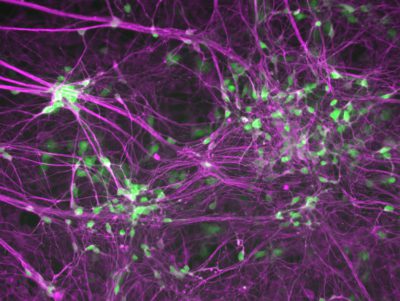By Cristy Lytal

Human induced motor neurons. Motor neurons are green, and neurons are purple. (Image courtesy of the Ichida Lab)
Each year in the U.S., 5,000 patients receive a diagnosis of ALS, an incurable neurodegenerative disease that will likely kill them within two to five years. In the quest to find a cure for these patients, a team of researchers led by USC Stem Cell scientist Justin Ichida has identified two promising avenues for developing new treatments for diverse forms of this devastating disease, which is also known as amyotrophic lateral sclerosis or Lou Gehrig’s disease. Their findings are published in a pair of studies: the first appearing in the journal Cell Stem Cell on February 2, and the second in the journal Cell on February 7.
“A minority of patients have a variety of genetic causes of ALS that can be inherited within families, and a majority have what is known as “sporadic” disease because its causes are unknown,” said Gabriel Linares, a postdoc in the Ichida lab and a co-first author on both studies. “This makes it a difficult challenge to find one treatment that will work for all patients with ALS.”
To meet this challenge, the researchers collected skin or blood samples from patients with both familial and sporadic ALS. The scientists reprogrammed the skin and blood cells into motor neurons, which are the nerve cells responsible for movement that degenerate in the disease. These patient-derived motor neurons provided an opportunity to screen thousands of FDA-approved drugs and drug-like molecules to find ones that might be effective against multiple forms of ALS. (…Read More)